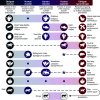A universally applicable definition for domestication
- PMID: 40372471
- PMCID: PMC12146738
- DOI: 10.1073/pnas.2413207122
A universally applicable definition for domestication
Abstract
The process of domestication is commonly perceived as a human achievement, and domestic species are typically assumed to be those under human control. Domestic species have emerged from a greater diversity of interactions than this perspective allows, and none of the many definitions proposed for domestication can readily, reliably, and consistently distinguish domestic and nondomestic populations. Here, we propose that the process of domestication should instead be defined solely as evolution of a nonhuman population in response to an anthropogenic niche and that a domestic population is one that cannot sustain itself outside of an anthropogenic niche. As a result, this definition does not require comparisons with a presumed and largely unobservable ancestor. Instead, it focuses on the observable relationship between a nonhuman population and humans. It also avoids making assumptions about how domestication happens, thus enabling an exploration of the mechanisms underlying the process of adaptation to an anthropogenic niche. By applying this definition to plants, animals, and microbes, we illustrate its utility for investigating the evolution of the relationship between humans and other species and for anticipating which species are likely to survive in an increasingly human-influenced world. Domestication is simply an evolutionary process resulting from the interaction between two species, one of which is human. As we work to protect Earth's biodiversity, this definition allows us to understand why, in response to the conditions human societies create, some species survive and thrive, while others struggle and go extinct.
Keywords: anthropogenic; biodiversity; extinction; natural selection; symbiosis.
Conflict of interest statement
Competing interests statement:The authors declare no competing interest.
Figures



Similar articles
-
Qualitative Study.2022 Sep 18. In: StatPearls [Internet]. Treasure Island (FL): StatPearls Publishing; 2025 Jan–. 2022 Sep 18. In: StatPearls [Internet]. Treasure Island (FL): StatPearls Publishing; 2025 Jan–. PMID: 29262162 Free Books & Documents.
-
Human domestication and the roles of human agency in human evolution.Hist Philos Life Sci. 2020 May 26;42(2):21. doi: 10.1007/s40656-020-00315-0. Hist Philos Life Sci. 2020. PMID: 32458082 Free PMC article.
-
Assessing elements of an extended evolutionary synthesis for plant domestication and agricultural origin research.Proc Natl Acad Sci U S A. 2017 Jun 20;114(25):6429-6437. doi: 10.1073/pnas.1703658114. Epub 2017 Jun 2. Proc Natl Acad Sci U S A. 2017. PMID: 28576881 Free PMC article.
-
Understanding human-commensalism through an ecological and evolutionary framework.Trends Ecol Evol. 2025 Feb;40(2):159-169. doi: 10.1016/j.tree.2024.10.006. Epub 2024 Nov 13. Trends Ecol Evol. 2025. PMID: 39542789 Review.
-
Molecular genetic variation of animals and plants under domestication.Proc Natl Acad Sci U S A. 2022 Jul 26;119(30):e2122150119. doi: 10.1073/pnas.2122150119. Epub 2022 Jul 18. Proc Natl Acad Sci U S A. 2022. PMID: 35858409 Free PMC article. Review.
References
-
- Ramankutty N., Evan A. T., Monfreda C., Foley J. A., Farming the planet: 1. Geographic distribution of global agricultural lands in the year 2000. Global Biogeochem. Cycles 22, GB1003 (2008).
-
- Larson G., Burger J., A population genetics view of animal domestication. Trends Genet. 29, 197–205 (2013). - PubMed
MeSH terms
LinkOut - more resources
Full Text Sources
Research Materials

